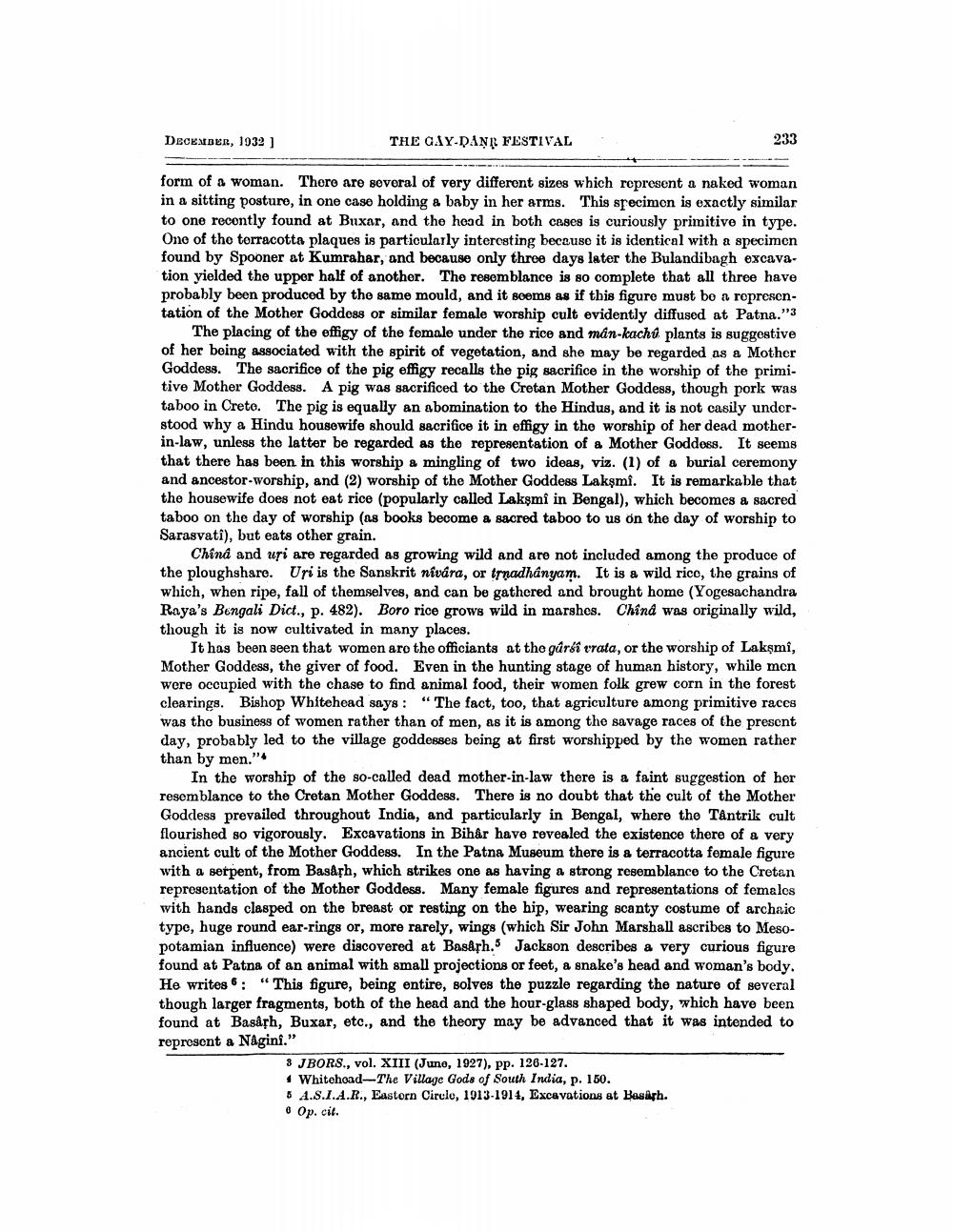________________
233
DECEMBER, 1932 ]
THE GAY-DANR FESTIVAL = form of a woman. There are several of very different sizes which represent a naked woman in a sitting posture, in one case holding a baby in her arms. This specimen is exactly similar to one recently found at Buxar, and the head in both cases is curiously primitive in type. One of the torracotta plaques is particularly interesting because it is identical with a specimen found by Spooner at Kumrahar, and because only three days later the Bulandibagh excavation yielded the upper half of another. The resemblance is so complete that all three have probably been produced by the same mould, and it seems as if this figure must be a representation of the Mother Goddess or similar female worship cult evidently diffused at Patna.”3
The placing of the effigy of the female under the rice and man-kacho plants is suggestive of her being associated with the spirit of vegetation, and she may be regarded as a Mother Goddess. The sacrifice of the pig effigy recalls the pig sacrifice in the worship of the primitive Mother Goddess. A pig was sacrificed to the Cretan Mother Goddess, though pork was taboo in Crete. The pig is equally an abomination to the Hindus, and it is not casily understood why a Hindu housewife should sacrifice it in effigy in the worship of her dead motherin-law, unless the latter be regarded as the representation of a Mother Goddess. It seems that there has been in this worship a mingling of two ideas, viz. (1) of a burial ceremony and ancestor-worship, and (2) worship of the Mother Goddess Lakşmi. It is remarkable that the housewife does not eat rice (popularly called Lakşmi in Bengal), which becomes a sacred taboo on the day of worship (as books become a sacred taboo to us on the day of worship to Sarasvati), but eats other grain.
China and uri are regarded as growing wild and are not included among the produce of the ploughshare. Uri is the Sanskrit nivára, or trnadhanyam. It is a wild rice, the grains of which, when ripe, fall of themselves, and can be gathered and brought home (Yogesachandra Raya's Bengali Dict., p. 482). Boro rice grows wild in marshes. Chind was originally wild, though it is now cultivated in many places.
It has been seen that women are the officiants at the garbi vrata, or the worship of Lakşmi, Mother Goddess, the giver of food. Even in the hunting stage of human history, while mon were occupied with the chase to find animal food, their women folk grew corn in the forest clearings. Bishop Whitehead says: “The fact, too, that agriculture among primitive races was the business of women rather than of men, as it is among the savage races of the present day, probably led to the village goddesses being at first worshipped by the women rather than by men."
In the worship of the so-called dead mother-in-law there is a faint suggestion of her resemblance to the Cretan Mother Goddess. There is no doubt that the cult of the Mother Goddess prevailed throughout India, and particularly in Bengal, where the Tantrik cult flourished so vigorously. Excavations in Bihår have revealed the existence there of a very ancient cult of the Mother Goddess. In the Patna Museum there is a terracotta female figure with a serpent, from Bas&ph, which strikes one as having a strong resemblance to the Cretan representation of the Mother Goddess. Many female figures and representations of females with hands clasped on the breast or resting on the hip, wearing scanty costume of archaic type, huge round ear-rings or, more rarely, wings (which Sir John Marshall ascribes to Mesopotamian influence) were discovered at Basaph.5 Jackson describes a very curious figure found at Patna of an animal with small projections or feet, a snake's head and woman's body. He writes 6: “This figure, being entire, solves the puzzle regarding the nature of several though larger fragments, both of the head and the hour-glass shaped body, which have been found at Basah, Buxar, etc., and the theory may be advanced that it was intended to represent a Nagini."
8 JBORS., vol. XIII (June, 1927), pp. 126-127. 1 Whitehoad-The Village Gods of South India, p. 160. 6 A.S.I.A.R., Eastorn Circlo, 1913-1914, Excavations at Basah. 0 Op. cit.




